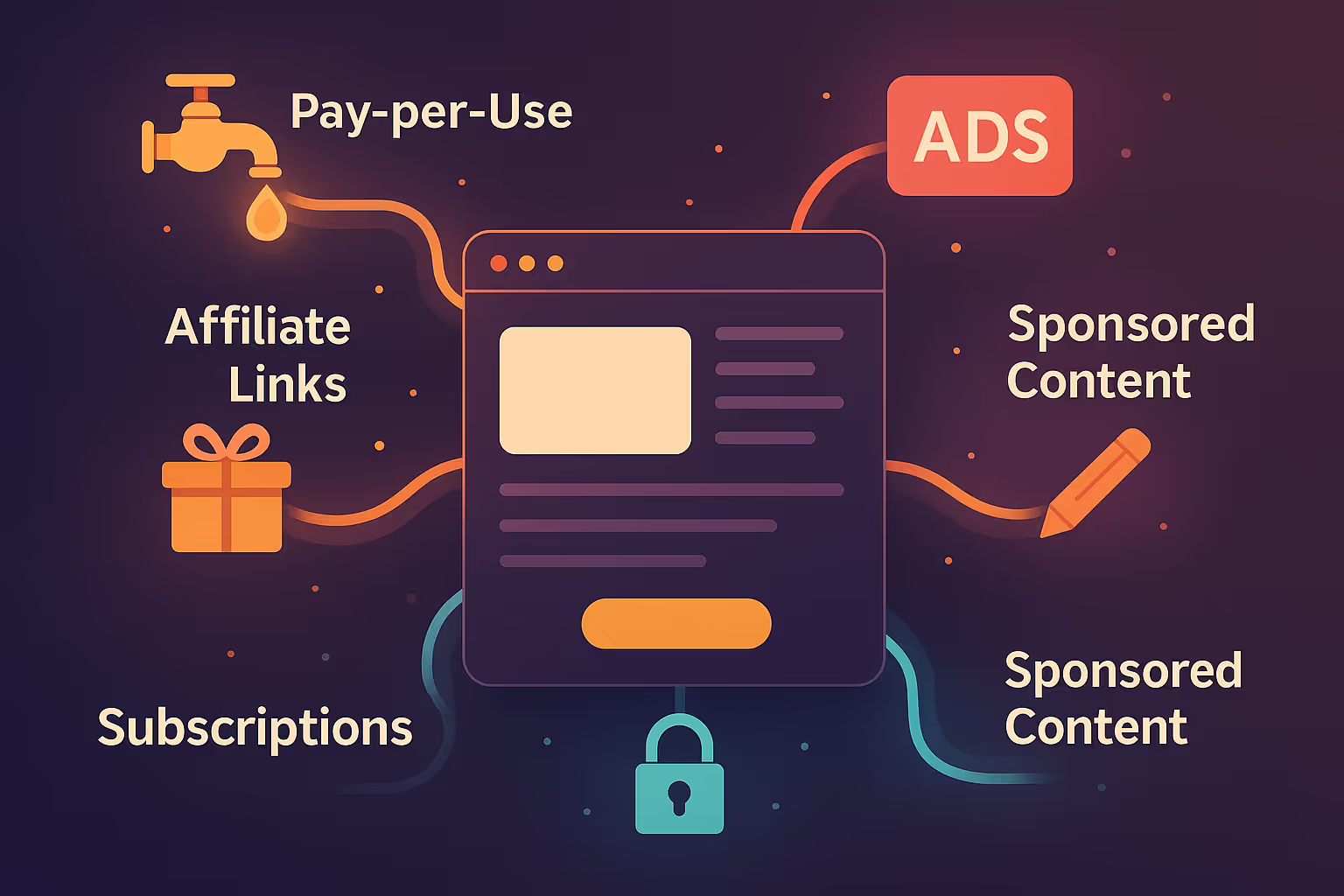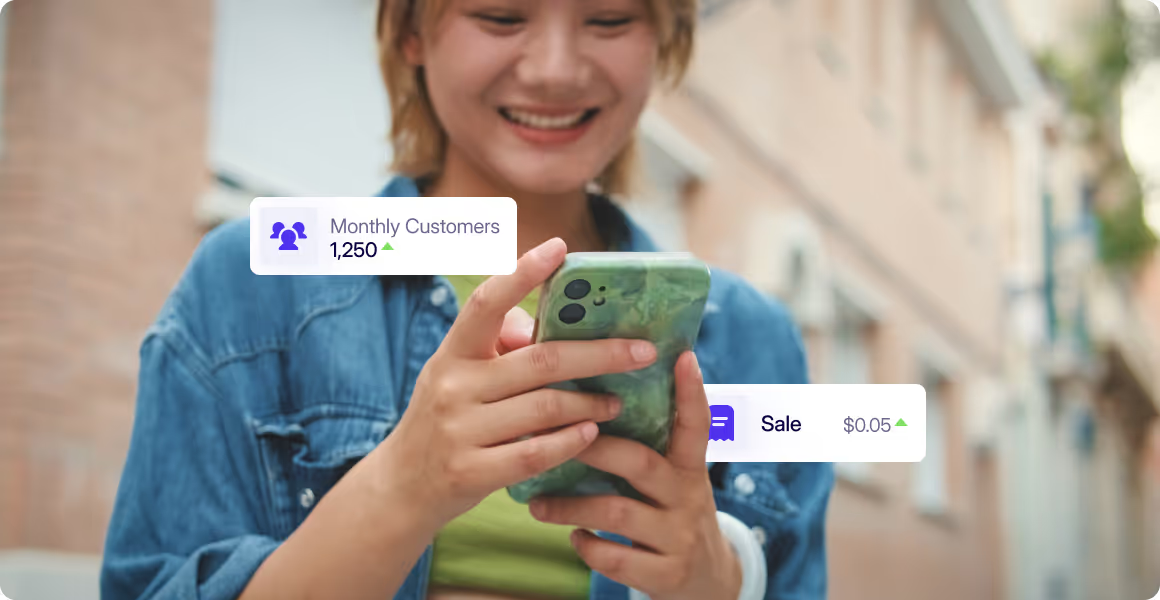In today’s online business market, it can be challenging to choose the best way to monetize a website. With various options offering different advantages, your monetization choices can alienate your regular customers just as effectively as they can attract new ones.
In this guide, we’ll discuss the best ways to generate website revenue without compromising on the quality of the user experience or losing your established customer base.
We’ll also discuss alternatives to disruptive methods, such as pop-up ads, so that you can balance value-filled content with lucrative, scalable marketing methods that can promote your website’s growth, conversions, and operational efficiency.
8 Proven Website Monetization Tactics
Here are eight powerful and proven ways you can start monetizing your website:
Display Advertising (Google AdSense, Direct Ads)
Display advertising, or visual ads that appear on websites and social media, is one of the most popular ways to monetize your website. Still, it’s not necessarily the most profitable. Especially when considering that nearly a third of all internet users report using an ad-blocker.
Popular advertising networks, such as Google AdSense, enable you to implement customizable ads that are guaranteed to be relevant to your content and can earn revenue based on clicks or impressions. But even as a quiet revenue builder, it’s unlikely to be a money-maker unless you’re bringing in some serious traffic.
Affiliate Marketing
Affiliate marketing is a low-lift, high-reward monetization tactic where you promote products or services and earn a commission for every sale or action generated through your unique link. It’s especially effective for niche websites with engaged audiences who trust your recommendations.
For example, if a hiking blog wanted to use affiliate marketing to monetize their gear reviews, they could link to products like boots and backpacks through REI’s affiliate program. When readers click and make a purchase, the hiking blog earns a commission, converting its expert content into a steady revenue stream.
The key is to partner with brands that align with your content and prioritize authenticity, as readers can spot forced promotions from a mile away. You can start with affiliate networks like Amazon Associates or ShareASale, or consider niche-specific programs tailored to your interests.
Sponsored Content and Native Ads
Sponsored content is when someone from an adjacent industry or niche pays you to advertise something on your website. This content can take the form of paid reviews, sales announcements, product launches, or other offers.
Sponsored content can then be written by either your website copywriters or the sponsoring brand, depending on the agreement. Unlike display ads, these formats feel natural, making them less disruptive and more engaging.
For example, a sustainable home and lifestyle website can monetize its content by partnering with eco-friendly brands through sponsored posts. They can publish a sponsored article titled “5 Stylish, Sustainable Storage Solutions,” featuring products from a bamboo furniture company. The post aligns with their tone and audience interests, offering genuine value while generating revenue through the brand partnership.
Sponsored posts can be an effective money-maker, but it’s dangerous to over-rely on these posts. That said, the data shows that sponsored content generates 59% more brand recognition than traditional display ads.
Selling Digital Products
If you have the in-demand knowledge, selling digital products is an effective way to monetize your website. The distribution costs are minimal, and you’ll always have reusable stock once you create products like eBooks, templates, online courses, or digital art.
In 2024 alone, internet users spent over $560 billion on digital media, including videos, e-publishing, digital music, and video games. The key is creating high-quality resources that solve specific problems or add value. Platforms like Gumroad, Teachable, or Shopify make it easy to host and sell.
Subscriptions or Membership Models
Depending on the size of your customer base, you can also adopt a subscription or membership model for your website. With these models, you’ll offer exclusive access to your online content, products, or services for a monthly or annual fee, generating predictable income for your business.
To suit your budget and needs, you can also incorporate a tiered pricing system with varying levels of complementary access to your content. If you’re trying to encourage your visitors to subscribe, consider offering free trials or occasionally revealing content that would previously only be available to subscribers.
Paywalls and Premium Articles
Paywalls are a proven method for monetizing high-value content, particularly for sites that offer original research, expert insights, or niche reporting. By gating select articles or offering a tiered access model, you encourage casual readers to become paying subscribers.
This model works best when your content consistently delivers value that readers can’t get elsewhere, such as in-depth guides, exclusive interviews, or data-driven reports. Soft paywalls (where some content remains free) often convert better than hard paywalls, which block all access.
While paywalls are a great way to monetize your website, they are also a reliable way to lose customers if they’re too frequent. In fact, 60% of people report that they actively avoid sites that they know have paywalls. The key is finding a model that captures value without completely cutting off access. If full subscriptions aren’t the right fit for your audience, there are still flexible ways to monetize selectively.
Pay-Per-Use or Microtransactions
Microtransactions can be understood as a more subtle or refined version of subscription models. In this model, users are charged for access to specific written content, services, or software when they utilize it.
Microtransactions are more commonly seen in gaming, but now more and more websites and platforms are seeing their benefits. That’s because microtransactions are ideal for websites with a wide range of casual or one-time visitors who may not be ready for a subscription but are still willing to pay for value.
Platforms like Supertab make this model easy to implement, letting you monetize individual assets while preserving user trust and maximizing engagement across your content.
Freemium Tools and Services
Freemium is a business model that offers basic features of a product or service to users at no cost, while charging a premium for supplemental or advanced features. Compared to other methods, this gives users a risk-free way to try your product or service.
This model works best when the free tier is genuinely helpful, and the premium tier solves a deeper need or removes friction. Over time, a strong freemium setup can drive recurring revenue while expanding your user base.
Selling Physical Products or Merchandise
In addition to or as an alternative to digital products, you can also monetize your website through selling physical products or merchandise. This will add a hands-on element to your business, deepening your relationship with your customers.
Whether it’s apparel, mugs, notebooks, or niche-specific gear, physical products let your visitors represent and support your brand in the real world. This strategy is particularly effective for community-driven sites with a loyal following.
You don’t even need to manage inventory yourself; print-on-demand services like Printful or Teespring handle production and fulfillment. The key is offering items that resonate with your audience’s identity or values. Even a small, well-curated merch shop can boost revenue while building brand affinity and turning loyal readers into brand ambassadors.
Make Every Visit Count: Get Started with Supertab’s Monetization Platform
Your website traffic is valuable; don’t let it go to waste. Supertab helps you monetize every visit with flexible, user-friendly tools designed for modern websites.
With a range of integrations from instant Google Ad Manager to full API access, Supertab can fit any team’s technical capacity. And with its deferred microtransaction system, you’ll be able to capture revenue from the customer who never had the chance to see your business’s value.
If you’re ready to monetize your website the right way in 2025, explore Supertab today and discover smarter ways to turn engagement into revenue, one click at a time.



.svg)

.avif)


